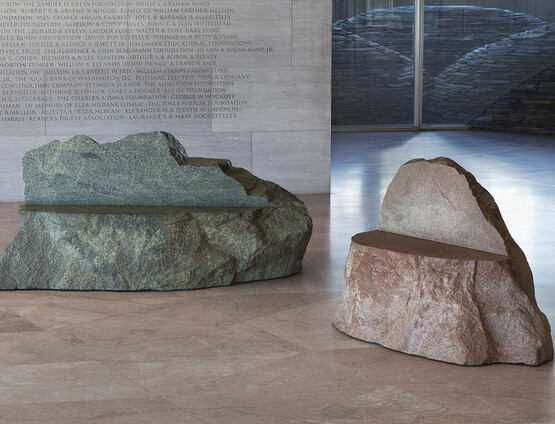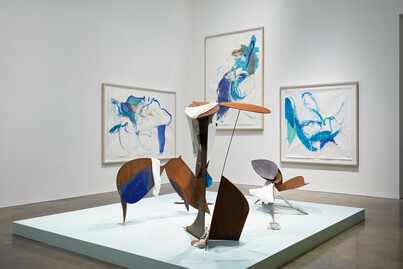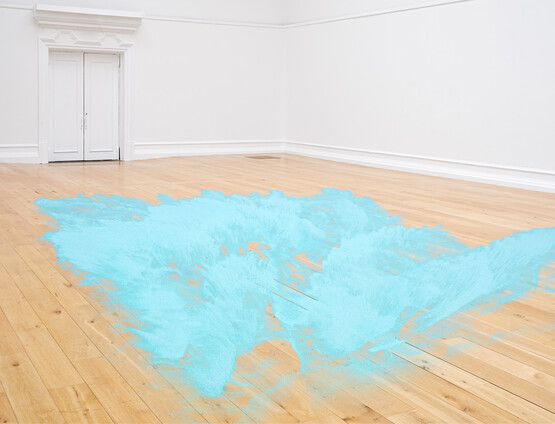

Ro Robertson
by Kirsty White
Articles /
Artist profile
• 01.11.2023
Four years ago, Ro Robertson (b.1984) began pouring plaster into the fractures of natural rock formations FIG.1. This decision stemmed from an interest in stone and, despite its apparent hardness, its potential for fluctuation and transformation through continual natural processes, such as erosion. The excavated casts were lumpy and misshapen, but delicate, resembling the petals of a flower or a vulva. For Robertson, they were a more encompassing way to produce work about the body: ‘I haven’t made these shapes, they are formed by nature and to a degree by chance. I do as little to them as possible, [yet] the results are surprisingly anthropomorphic. It could be any body. [They’re] universal’.1
All of Robertson’s work can be understood as a similar exercise in recognition, setting up a dialogue about the queer body with a public who may, or may not, be familiar with it. In a recent article they wrote that in making these casts, they considered ‘the sculptural void’ to be in direct correlation with the void that queer people experience as a result of widespread homophobic and transphobic violence.2 Here, the void – long a recurring theme in sculpture – is not only a material absence designed to frame the sculpture and its surroundings, but it is also a societal reality. It is a hole that shrouds queer people from mainstream consciousness, leaving them all the more open to persecution and discrimination.
These formal experiments led to Robertson’s first public sculpture, Stone (Butch) FIG.2, which was initially exhibited in London in 2021 as part of Sculpture in the City, and later installed at Yorkshire Sculpture Park, Wakefield. The large sprawling sculpture is cast in jesmonite, which appears to have been snap-dried, and is perched on two rusted-steel, semi-circular legs. The title alludes to the 1993 novel Stone Butch Blues by the lesbian and transgender activist Leslie Feinberg, which popularised the term ‘stone butch’ in reference to people who identify as lesbian and/or transgender and present in a more traditionally ‘masculine’ manner. In particular, Robertson was drawn to an event described in the novel in which a person is referred to as ‘the most stone butch of them all’, who took to wearing ‘a raincoat in the shower’.3 In response to this idea of extreme vulnerability – that one would not want even water to touch their skin – Robertson coined the term ‘raincoat layer’, which refers to a notional covering or shield that ‘protects the body from external forces’ but also relates to the experience of disconnection from one’s environment that many LGBTQIA+ people feel, caused by society deeming them to be ‘against nature’.4
This feeling of estrangement is rooted in Robertson’s personal experience. Born in Sunderland, they moved to Newcastle and then Manchester in 2007 to study Fine Art, where they made sound and performance works inspired by the city’s experimental DIY music scene and such artists as Yvonne Rainer (b.1934) and Carolee Schneemann (1939–2019). Although in Manchester they found access to a queer community and culture that was not available to them previously, they felt alienated from the natural landscape. When they moved to Hebden Bridge in 2016, they no longer felt the natural landscape ‘was theirs to explore’ – not only because it lacked the safe spaces and communities they relied on, but also because they could not identify with Britain’s largely white, cisgendered and heteronormative pastoral tradition.5
In 2019 Robertson relocated to Cornwall, from which point nature and the sea, particularly the changeability of water, has featured increasingly in their work. Their public sculpture Drench FIG.3 is a reference to the tidal zone – the area of the coastline that is submerged at high tide and exposed at low tide, which Robertson describes as a ‘space of great energy and transformation and flux […] a space for freedom’.6 Belonging both to the beach and the sea, depending on the time of day, the tidal zone itself could be understood as eluding binary definition. The sculpture features a series of wave-like shapes that rise out of the grass in ascending order. Taken from drawings they made as a precursor to the three-dimensional work, the half-painted, half-rusted steel forms feature gaps that were conceived of as voids – here, in a more literal sense – for people to look through. The work epitomises the artist’s interest in the relationship between sculpture and the body and how people take up and use space. In addition, in a time of rising sea levels, the work’s swelling, wave-like structure also takes on ecological connotations, its title perhaps a stark warning.
Many of Robertson’s sculptures begin life as drawings, which are often created using the Surrealist method of automatic drawing. For the artist, this affords them a way of circumventing binary structures, by working in the liminal zone between unconscious ideation and physical action. The symmetry in the recent Outer Body FIG.4, for example – a semi-abstract welded steel sculpture – stems from a preliminary drawing FIG.5. This equilibrium alludes both to the grounding qualities of an anchor – here, symbolic of a resistance to the disconnection that queer people can feel from their own bodies or environments – and the strength of a labrys, the double-headed axe associated with female gods in the Minoan religion, which became a lesbian feminist symbol in the 1970s. Of all Robertson’s sculptures, it is the most evocative of armour: it is rife with sharp edges and points; the rusted steel is weathered and worn, as though it has endured battle.
Whereas Outer Body directly references Robertson’s notion of the ‘raincoat layer’, other sculptures that the artist makes for interior, gallery spaces approach this theme in different ways. For example, Torsos FIG.6 exudes a playfulness that is at odds with the protective qualities of Outer Body. Here, curved steel forms are positioned at various angles, so that they come to resemble graceful figures, reclining or leaning on a hip or leg. White cotton vests are stretched taut over the metal sheets; a pair of blue satin boxer shorts is draped over the lower half of one sculpture FIG.7. By contrast, Outer Body is staunch, whetted and weaponised. Here lies a tension in Robertson’s practice: between the more abstracted sculptures, which manifest the ‘raincoat layer’ in their blade-like forms, and the more figurative works that celebrate the queer body rather than visibly seeking to protect it. However, if all of Robertson’s sculptures can be understood as a metaphor for the body, at a notional level, the ‘raincoat layer’ becomes the work of art itself and the sculpture stands in as a proxy for the artist, prompting debate in the public realm in their place.
Nowhere is this more apparent than Robertson’s largest public sculpture commission thus far, The Source FIG.8 FIG.9, a twenty-metre-long sculptural walkway and garden designed for Wakefield city centre. Set to be installed in early 2024 on a street named The Springs, which up until 1837 was Wakefield’s main source of water, the sculpture will give residents an outdoor space that they can use and, if they wish, be involved in its maintenance. The watery forms that comprise the work recall the site’s aqueous history, as well as non-binary and fluid gender identities. Robertson has worked against the usual connotations of steel – hardness, rigidity, strength – to produce a sculpture that has no straight lines. Furthermore, in making a garden that grows and changes over time, The Source gains a degree of independence and autonomy not previously seen in Robertson’s work. It is the first time they have created a green space as opposed to working within an existing one, and through facilitating access to such an environment in the city, the sculpture will serve as a reminder of both the vital importance and precarious future of our natural resources.
Robertson’s practice evokes the work of both contemporary and historical artists, as evidenced by their use of automatic drawing and the Sarah-Lucas-like white vests in Torsos. Therefore, one might be compelled to place Robertson’s work into a sculptural lineage – to attribute their use of the void to Gordon Matta-Clark (1943–78), or their interest in negative space to Rachel Whiteread (b.1963), for example. However, this task is not as straightforward as it may seem – and not only because of a lack of queer artists represented in the traditional art-historical canon. Indeed, when working on Stone (Butch) and the video project Packing FIG.10 in 2019, Robertson attempted to construct an alternative, queer cannon, grouping their work alongside that of other non-binary artists. Although this approach has some merit and allows for a reclaiming of queer and historical narratives, it also comes with its own problems: by its very nature, a canon suggests the kind of monumentality Robertson that is actively trying to avoid. Furthermore, it engenders its own binaries, such as exclusion or inclusion.
In conversation with the writer Aja Romano, Cáel Keegan – an associate professor of women, gender and sexuality at Grand Valley State University, Allendale – noted that ‘so much of queerness is about learning to define yourself through opposition and define yourself through deviance, embracing your villainy’.7 Romano adds in response: ‘and recognizing that in the villainy there is value, and that villainy is required to alter the system in any kind of meaningful way’.8 As such, it is perhaps more meaningful to accept Robertson’s practice on thematic terms: in its focus on nature, the climate crisis and the limits of human action. Often drawing attention to the transitional, in-between spaces that occur naturally in our environment, Robertson suggests a way forwards that relies on plurality – a necessity if humankind is to look beyond the earth as a resource to be mined for our convenience.
Footnotes
- Ro Robertson, in phone correspondence with the present author, 14th July 2023. footnote 1
- R. Robertson: ‘Dancing in the rain’, Tate Etc. 56 (autumn 2022), available at www.tate.org.uk/tate-etc/issue-56-autumn-2022/dancing-in-the-rain, accessed 8th October 2023. footnote 2
- L. Feinberg: Stone Butch Blues, New York 1993, available at www.lesliefeinberg.net, accessed 26th June 2023. footnote 3
- Robertson, op. cit. (note 2). footnote 4
- Robertson, op. cit. (note 1). footnote 5
- Ro Robertson, quoted from ‘Drench | Frieze Sculpture 2022’, available at www.youtube.com/watch?v=kPReL6fQuAo, accessed 26th July 2023. footnote 6
- Cáel Keegan, quoted from A. Romano: ‘Why we need a new queer canon’, Vox (27th June 2022), available at www.vox.com/culture/23181998/new-queer-canon-the-matrix-contrapoints-celluloid-closet-history-cael-keegan-interview, accessed 18th October 2023. footnote 7
- Ibid. footnote 8



.jpg)






-1.jpg)
-1.jpg)

